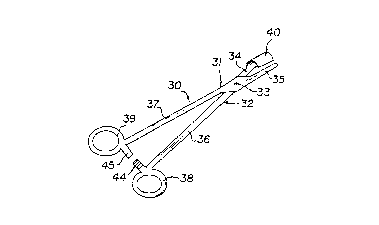Some of the information on this Web page has been provided by external sources. The Government of Canada is not responsible for the accuracy, reliability or currency of the information supplied by external sources. Users wishing to rely upon this information should consult directly with the source of the information. Content provided by external sources is not subject to official languages, privacy and accessibility requirements.
Any discrepancies in the text and image of the Claims and Abstract are due to differing posting times. Text of the Claims and Abstract are posted:
| (12) Patent Application: | (11) CA 2184326 |
|---|---|
| (54) English Title: | SURGICAL INSTRUMENT FOR SUTURING |
| (54) French Title: | INSTRUMENT CHIRURGICAL POUR SUTURES |
| Status: | Deemed Abandoned and Beyond the Period of Reinstatement - Pending Response to Notice of Disregarded Communication |
| (51) International Patent Classification (IPC): |
|
|---|---|
| (72) Inventors : |
|
| (73) Owners : |
|
| (71) Applicants : |
|
| (74) Agent: | RICHES, MCKENZIE & HERBERT LLP |
| (74) Associate agent: | |
| (45) Issued: | |
| (22) Filed Date: | 1996-08-28 |
| (41) Open to Public Inspection: | 1998-03-01 |
| Availability of licence: | N/A |
| Dedicated to the Public: | N/A |
| (25) Language of filing: | English |
| Patent Cooperation Treaty (PCT): | No |
|---|
| (30) Application Priority Data: | None |
|---|
A surgical device is used for manipulating suture needles. The device is formed of
two elongate members hinged together. On one side of the hinge, the elongate members form
a pair of jaws which are relatively moveable. One the other end of the elongate members
there are handles formed which allow the user to manipulate the jaws about the hinge. An
arcuate shield is integral with one of the jaws at its center. The shield extends laterally and
arcuately from the jaw and covers the opposing jaw. The placement of the shield is such
that a needle which is held between the jaws is protected from sticking any one or anything.
The jaw members may be made up of several units forming segmented jaws.
L'invention porte sur un dispositif chirurgical utilisé pour manipuler les aiguilles à suture. Le dispositif comporte deux éléments allongés articulés l'un à l'autre par une charnière. D'un côté de la charnière, les éléments allongés forment une mâchoire relativement mobile. Le dispositif comprend, à l'autre extrémité des éléments allongés, des anneaux qui permettent à l'utilisateur de manipuler la mâchoire près de la charnière. Un écran arqué est solidaire du centre d'un des éléments de la mâchoire. Il se prolonge latéralement et de façon arquée à partir d'un élément de la mâchoire et recouvre l'élément opposé. L'emplacement de l'écran est prévu pour qu'une aiguille tenue dans la mâchoire ne puisse piquer ni rien ni personne. Les éléments de la mâchoire peuvent comporter plusieurs unités formant une mâchoire segmentée.
Note: Claims are shown in the official language in which they were submitted.
Note: Descriptions are shown in the official language in which they were submitted.

2024-08-01:As part of the Next Generation Patents (NGP) transition, the Canadian Patents Database (CPD) now contains a more detailed Event History, which replicates the Event Log of our new back-office solution.
Please note that "Inactive:" events refers to events no longer in use in our new back-office solution.
For a clearer understanding of the status of the application/patent presented on this page, the site Disclaimer , as well as the definitions for Patent , Event History , Maintenance Fee and Payment History should be consulted.
| Description | Date |
|---|---|
| Inactive: IPC expired | 2016-01-01 |
| Inactive: IPC from MCD | 2006-03-12 |
| Time Limit for Reversal Expired | 2001-08-28 |
| Application Not Reinstated by Deadline | 2001-08-28 |
| Inactive: Cover page published | 2000-12-21 |
| Deemed Abandoned - Failure to Respond to Maintenance Fee Notice | 2000-08-28 |
| Application Published (Open to Public Inspection) | 1998-03-01 |
| Abandonment Date | Reason | Reinstatement Date |
|---|---|---|
| 2000-08-28 |
The last payment was received on 1999-06-15
Note : If the full payment has not been received on or before the date indicated, a further fee may be required which may be one of the following
Patent fees are adjusted on the 1st of January every year. The amounts above are the current amounts if received by December 31 of the current year.
Please refer to the CIPO
Patent Fees
web page to see all current fee amounts.
| Fee Type | Anniversary Year | Due Date | Paid Date |
|---|---|---|---|
| MF (application, 2nd anniv.) - small | 02 | 1998-08-28 | 1998-08-12 |
| MF (application, 3rd anniv.) - small | 03 | 1999-08-30 | 1999-06-15 |
Note: Records showing the ownership history in alphabetical order.
| Current Owners on Record |
|---|
| STEVEN B. HOEL |
| Past Owners on Record |
|---|
| None |